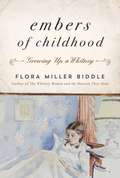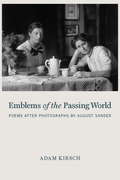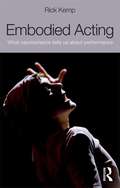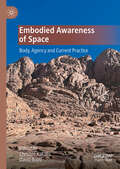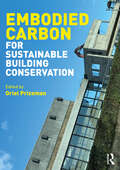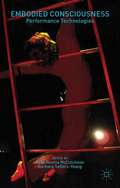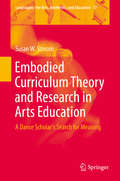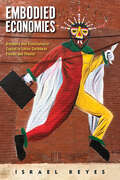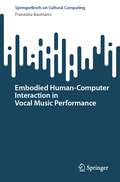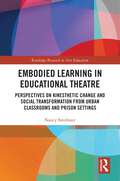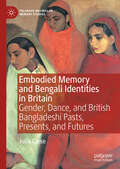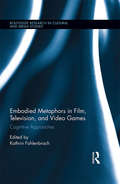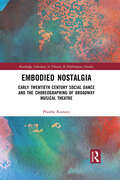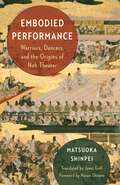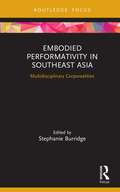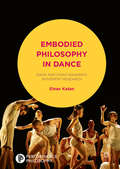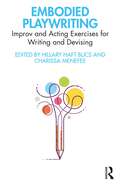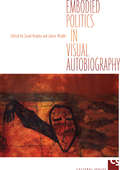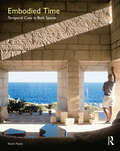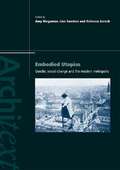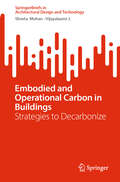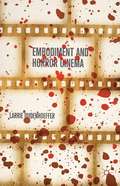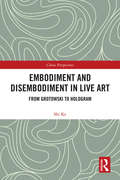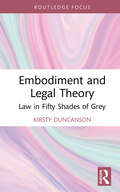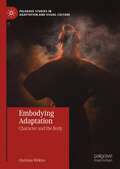- Table View
- List View
Embers of Childhood: Growing Up a Whitney
by Flora Miller BiddleA Look into the Privileged World of the American Aristocracy of the Early Twentieth Century Flora Miller Biddle was born a blue-blood. The granddaughter of the Whitney museum founder, Gertrude Vanderbilt Whitney, her childhood played out in a sort of Wharton landscape as she was shielded from the woes of the world. But money itself is not the source of happiness. Glimpses into the elegance of a Vanderbilt ball thrown by her great-grandparents and the yearly production of traveling from her childhood home on Long Island to their summer home in Aiken, South Carolina, are measured against memoires of strict governesses with stricter rules in a childhood separate from her parents, despite being in the same house, and the ever-present pressure to measure up in her studies and lessons. As Flora steps back in time to trace the origins of her family’s fortune and where it stands today, she takes a discerning look at how wealth and excess shaped her life, for better and for worse.In this wonderfully evocative memoir, Flora Miller Biddle examines, critiques, and pays homage to the people and places of her childhood that shaped her life.
Emblems of the Passing World
by Adam KirschAugust Sander's photographic portraits of ordinary people in Weimar Germany inspire this uncanny new collection of poems by one of America's most celebrated writers and criticsThrough his portraits of ordinary people--soldiers, housewives, children, peasants, and city dwellers--August Sander, the German photographer whose work chronicled the extreme tensions and transitions of the twentieth century, captured a moment in history whose consequences he himself couldn't have predicted. Using these photographs as a lens, Adam Kirsch's poems connect the legacy of the First World War with the turmoil of the Weimar Republic with moving immediacy and meditative insight, and foreshadow the Nazi era. Kirsch writes both urgently and poignantly about these photographs, creating a unique dialogue of word and image that will speak to all readers interested in history, past and present.
Embodied Acting: What Neuroscience Tells Us About Performance
by Rick Kemp‘A focus on the body, its actions, and its cognitive mechanisms identifies ... foundational principles of activity that link the three elements of theatre; Story, Space, and Time. The three meet in, are defined by, and expressed through the actor’s body.’ – from the Introduction Embodied Acting is an essential, pragmatic intervention in the study of how recent discoveries within cognitive science can – and should – be applied to performance. For too long, a conceptual separation of mind and body has dominated actor training in the West. Cognitive science has shown this binary to be illusory, shattering the traditional boundaries between mind and body, reason and emotion, knowledge and imagination. This revolutionary new volume explores the impact that a more holistic approach to the "bodymind" can have on the acting process. Drawing on his experience as an actor, director and scholar, Rick Kemp interrogates the key cognitive activities involved in performance, including: non-verbal communication the relationship between thought, speech, and gesture the relationship between self and character empathy, imagination, and emotion. New perspectives on the work of Stanislavski, Michael Chekhov, and Jacques Lecoq – as well as contemporary practitioners including Daniel Day-Lewis and Katie Mitchell – are explored through practical exercises and accessible explanations. Blending theory, practice, and cutting-edge neuroscience, Kemp presents a radical re-examination of the unconscious activities engaged in creating, and presenting, a role.
Embodied Awareness of Space: Body, Agency and Current Practice
by David Boyd Christos KakalisThis edited volume explores the notion of embodied experience through a diverse range of disciplines: architecture, music, literature, performance studies, philosophy, geopolitics. In doing so, it illuminates the need to redefine the role of the human body as one of the protagonists for raising awareness of space-time issues through processing, experimentation and application of histories and theories of embodied awareness of space. Critically revisiting these spatio-temporal dialogues, this book suggests a method of linking theory, history and practice: past, present and future. The authors reinstate the significance of history and theory in creative thinking, and test their applicability in a number of different areas: theoretical and buildable architectural projects, mapping and geography, representation, and performative arts. This volume will appeal to students and scholars from architecture, art, cultural studies, landscape studies, media studies, and other disciplines in the humanities and social sciences.
Embodied Carbon for Sustainable Building Conservation
by Oriel PrizemanThis timely volume provides the latest research, guidance, examples, and methods for understanding, calculating, leveraging, and reducing embodied carbon in building conservation. In the context of climate change and increasing energy costs, imperatives to replace or substantially modify older and historic buildings are rapidly accelerating. The idea that a new or replacement building will perform better overlooks the embodied carbon of that which it replaces. In effect, the pressures of one conservation agenda, that of energy efficiency, threaten to eclipse another, that of heritage. The embodied carbon of existing buildings must be addressed if calculations of operational energy use are to be properly balanced.In this book, an international and multi-disciplinary group of authors offer perspectives on the influence and implementation of strategies to account for embodied carbon for the conservation of the historic environment. Examples are deliberately diverse and extend beyond buildings to the valorisation of a heritage grassland landscape specifically because of its capacity to store carbon, to the fundamental attributes of historic concrete and our responsibility to consider replacement with critical care.This book inspires confidence in developing arguments by spreading examples globally and delivering plausible, actual narratives alongside clear up-to-date guidance. It brings together international standard-setters with practitioners, academics and advocates, all clearly explained. It also illustrates how embodied carbon played a pivotal role in seeking to determine the case of saving Marks and Spencer, Oxford Street, London, from replacement. This will be an essential resource for all building conservation and heritage practitioners including building surveyors, architects, conservators, engineers, conservation officers, building archaeologists and consultants.
Embodied Consciousness: Performance Technologies
by Barbara Sellers-Young Jade Rosina MccutcheonThis volume of essays combines research from neuroscience, conscious studies, methods of training performers, modes of creating a staged narrative, Asian aesthetics, and post-modern theories of performance in an examination of the relationship between consciousness and performance.
Embodied Curriculum Theory and Research in Arts Education
by Susan W. StinsonThis collection of articles by Susan W. Stinson, organized thematically and chronologically by the author, reveals the evolution of the field of arts education in general and dance education in particular, through narrative and critical reflections by this unique scholar and a few co-authors. It also includes contextual insights not available elsewhere. The author's pioneering embodied research work in arts and dance education continues to be relevant to researchers today. The selected chapters and articles were predominantly previously published in a variety of journals, conference proceedings and books between 1985 and the present. Each section is preceded by an introduction and the author has written a post scriptum for each article to offer a commentary or response to the article from the current perspective.
Embodied Economies: Diaspora and Transcultural Capital in Latinx Caribbean Fiction and Theater (Latinidad: Transnational Cultures in the United States)
by Israel ReyesHow do upwardly mobile Latinx Caribbean migrants leverage their cultural heritage to buy into the American Dream? In the neoliberal economy of the United States, the discourse of white nationalism compels upwardly mobile immigrants to trade in their ties to ethnic and linguistic communities to assimilate to the dominant culture. For Latinx Caribbean immigrants, exiles, and refugees this means abandoning Spanish, rejecting forms of communal inter-dependence, and adopting white, middle-class forms of embodiment to mitigate any ethnic and racial identity markers that might hinder their upwardly mobile trajectories. This transactional process of acquiring and trading in various kinds of material and embodied practices across traditions is a phenomenon author Israel Reyes terms “transcultural capital,” and it is this process he explores in the contemporary fiction and theater of the Latinx Caribbean diaspora. In chapters that compare works by Lin-Manuel Miranda, Nilo Cruz, Edwin Sánchez, Ángel Lozada, Rita Indiana Hernández, Dolores Prida, and Mayra Santos Febres, Reyes examines the contradictions of transcultural capital, its potential to establish networks of support in Latinx enclaves, and the risks it poses for reproducing the inequities of power and privilege that have always been at the heart of the American Dream. Embodied Economies shares new perspectives through its comparison of works written in both English and Spanish, and the literary voices that emerge from the US and the Hispanic Caribbean.
Embodied Human–Computer Interaction in Vocal Music Performance (Springer Series on Cultural Computing)
by Franziska BaumannThis SpringerBrief provides a unique insight into the practice and research of the connections between voice, HCI and embodiment. Specifically, it explores how the voice can be embodied and mediated by means of gestural communication through sensor interfaces and aims to situate and contextualise various aspects that generate meaningful connections in such interactive interface performance. The author offers an approach for understanding creative practices between humans and computers in gestural live music performance, from the perspective of the embodied relationships created within such systems. Underlying practices, principles and sensor technologies that support creativity in embodied human-computer interaction in vocal music performance are examined and a dynamic framework and tools for anyone wishing to engage with this subject in depth are presented. The book is essential reading not only for musicians, composers, researchers, application developers, musicologists and educators but also for students and tertiary institutions as well as actors and dramaturgs in a music context.
Embodied Learning in Educational Theatre: Perspectives on Kinesthetic Change and Social Transformation from Urban Classrooms and Prison Settings (Routledge Research in Arts Education)
by Nancy SmithnerThis book explores embodied teaching practices through applied and physical theatre, drawing extensively on the author’s rich experience teaching in diverse urban environments, including schools, colleges and prison settings.It presents a groundbreaking conceptualization of embodied practice aimed at fostering personal and social growth through educational theatre. Each chapter delves into theories of social transformation, supported by qualitative data from student reflections, to provide both theoretical and practical insights. These insights illustrate how physicalized pedagogy can be effectively used to engage students with socially transformative ideas and identities. It also emphasizes the significant role of the facilitator in this process, highlighting how they can create an environment that fosters ethical and multicultural awareness in both formal educational settings, such as classrooms, and informal settings, like community workshops. By promoting an ethos of inclusivity and ethical consideration, it argues that facilitators can help students navigate and engage with complex social issues through the medium of theatre.An accessible and compelling text, it aims to inspire educators to adopt innovative methods that promote deeper engagement and understanding among students.
Embodied Memory and Bengali Identities in Britain: Gender, Dance, and British Bangladeshi Pasts, Presents, and Futures (Palgrave Macmillan Memory Studies)
by Julia GieseThis book provides insight into the relationship between embodied processes and products of remembering and belonging among British Bangladeshi women in Tower Hamlets, London. Based on an analysis of memories performed in both professional and social dancing among British Bangladeshi women, as well as of the spaces and encounters that enable the production, transmission, and negotiation of such memories, this book addresses questions about the relationship between remembering and identification in the diaspora.
Embodied Metaphors in Film, Television, and Video Games: Cognitive Approaches (Routledge Research in Cultural and Media Studies)
by Kathrin FahlenbrachIn cognitive research, metaphors have been shown to help us imagine complex, abstract, or invisible ideas, concepts, or emotions. Contributors to this book argue that metaphors occur not only in language, but in audio visual media well. This is all the more evident in entertainment media, which strategically "sell" their products by addressing their viewers’ immediate, reflexive understanding through pictures, sounds, and language. This volume applies cognitive metaphor theory (CMT) to film, television, and video games in order to analyze the embodied aesthetics and meanings of those moving images.
Embodied Nostalgia: Early Twentieth Century Social Dance and the Choreographing of Broadway Musical Theatre (Routledge Advances in Theatre & Performance Studies)
by Phoebe RumseyEmbodied Nostalgia is a collection of interlocking case studies that focus on how social dance in musical theatre brings forth the dancer on stage as a site of embodied history, cultural memory, and nostalgia, and asks what social dance is doing performatively, dramaturgically, and critically in musical theatre. The case studies in this volume are all Broadway musicals set during the Jazz Age (1910-1950), however, performed and produced after that time, creating a spectrum of nostalgic impulses that are interrogated for social and political resonance and meaning. All reflect the fractures or changes in the social dance when brought to the stage and expose the complexities of the embodied nostalgia – broadly interpreted as the physicalizing of community memories, longings, and historical meaning – the dances carry with them. Particular attention is focused on the Black ownership of the social dances and the subsequent appropriation, cultural theft, and forgotten legacies. By approaching musical theatre through this lens of social dance––always already deeply connected to notions of class and race––and the politics of choreography therein, a unique and necessary method to describing, discussing, and critically evaluating the body in motion in musical theatre is put forth.
Embodied Performance: Warriors, Dancers, and the Origins of Noh Theater
by 1 Shinpei MatsuokaIn this groundbreaking book, Matsuoka Shinpei—a leading scholar of noh theater—provides a detailed account of the birth of one of Japan’s most celebrated art forms. Although noh has often been associated with the elite, Embodied Performance explores its links to a wider popular culture, revealing a rich and colorful public space where courtiers and commoners mingled.Matsuoka traces noh’s connections to popular and religious dances, linked verse, and chigo (beautiful temple boy) culture, emphasizing performance and the body. He describes the world of noh playwright Zeami as well as his views on dramaturgy and performance—and argues that Zeami was once a chigo. Matsuoka shows how religious rituals and cultural forms like ecstatic dance prayer and plays about demons in hell attracted people on the margins. Such activities, Matsuoka contends, drew on the tension between wild acrobatic movement and corporeal restraint, influencing the development of noh as well as the art of flower arranging and the tea ceremony. Janet Goff’s translation makes available in English a classic work of Japanese scholarship that will be invaluable to those interested in medieval Japanese culture, noh, and theatrical practice.
Embodied Performativity in Southeast Asia: Multidisciplinary Corporealities (Routledge Contemporary Southeast Asia Series)
by Stephanie BurridgeA collection presenting cutting edge research from music, dance, performance art, fashion and visual arts, written by scholar-practitioners working in Southeast Asia. This eclectic monograph explores multi-disciplinarily performativity through the body. Exploring the notion of the body as central to creative practice it draws together conversations centring on innovation through embodied knowledge relating to space, time and place. The authors in this collection are leaders in their field and recognized internationally. Their chapters represent new directions in thought and practice by game-changers in the arts. Underpinned by a central theme of corporeality, it is bold and innovative in its scope and range, bringing diverse disciplines together. It enables connections that create new ways of critically exploring corporeality extending beyond physicality and the traditional body-centred areas of performing arts practice. Insightful and stimulating reading for students, scholars and practitioners across the tertiary arts sector, as well as education, therapy, cultural studies and interdisciplinary arts.
Embodied Philosophy in Dance
by Einav KatanRepresenting the first comprehensive analysis of Gaga and Ohad Naharin's aesthetic approach, this book following the sensual and mental emphases of the movement research practiced by dancers of the Batsheva Dance Company. Considering the body as a means of expression, Embodied Philosophy in Dance deciphers forms of meaning in dance as a medium for perception and realization within the body. In doing so, the book addresses embodied philosophies of mind, hermeneutics, pragmatism, and social theories in order to illuminate the perceptual experience of dancing. It also reveals the interconnections between physical and mental processes of reasoning and explores the nature of physical intelligence.
Embodied Playwriting: Improv and Acting Exercises for Writing and Devising
by Hillary Haft Bucs Charissa MenefeeEmbodied Playwriting: Improv and Acting Exercises for Writing and Devising is the first book to compile new and adapted exercises for teaching playwriting in the classroom, workshop, or studio through the lens of acting and improvisation. The book provides access to the innovative practices developed by seasoned playwriting teachers from around the world who are also actors, improv performers, and theatre directors. Borrowing from the embodied art of acting and the inventive practice of improvisation, the exercises in this book will engage readers in performance-based methods that lead to the creation of fully imagined characters, dynamic relationships, and vivid drama. Step-by-step guidelines for exercises, as well as application and coaching advice, will support successful lesson planning and classroom implementation for playwriting students at all levels, as well as individual study. Readers will also benefit from curation by editors who have experience with high-impact educational practices and are advocates for the use of varied teaching strategies to increase accessibility, inclusion, skill-building, and student success. Embodied Playwriting offers a wealth of material for teachers and students of playwriting courses, as well as playwrights who look forward to experimenting with dynamic, embodied writing practices.
Embodied Politics in Visual Autobiography
by Sarah Brophy Janice HladkiFrom reality television to film, performance, and video art, autobiography is everywhere in today's image-obsessed age. With contributions by both artists and scholars, Embodied Politics in Visual Autobiography is a unique examination of visual autobiography's involvement in the global cultural politics of health, disability, and the body. This provocative collection looks at images of selfhood and embodiment in a variety of media and with a particular focus on bodily identities and practices that challenge the norm: a pregnant man in cyberspace, a fat activist performance troupe, indigenous artists intervening in museums, transnational selves who connect disability to war, and many more.The chapters in Embodied Politics in Visual Autobiography reflect several different theoretical approaches but share a common concern with the ways in which visual culture can generate resistance, critique, and creative interventions. With contributions that investigate digital media, installation art, graphic memoir, performance, film, reality television, photography, and video art, the collection offers a wide-ranging critical account of what is clearly becoming one of the most important issues in contemporary culture.
Embodied Time: Temporal Cues in Built Spaces
by Kevin NuteThe word time occurs more than seven times as often as space in written English, yet in the design of the indoor environments where we now spend most of our lives these priorities are typically reversed, with time often being little more than an afterthought. Embodied Time endeavors to correct that imbalance by demonstrating how built environments can be designed to evoke positive recollections of the past, interactions with the present, and anticipations of the future.
Embodied Utopias: Gender, Social Change and the Modern Metropolis (Architext)
by Rebecca Zorach Amy Bingaman Lise SandersUtopia has become a dirty word in recent scholarship on modernism, architecture, urban planning and gender studies. Many utopian designs now appear impractical, manifesting an arrogant disregard for the lived experiences of the ordinary inhabitants who make daily use of global public and private spaces. The essays in Embodied Utopias argue that the gendered body is the crux of the hopes and disappointments of modern urban and suburban utopias of the Americas, Europe and Asia. They reassess utopian projects - masculinist, feminist, colonialist, progressive - of the late nineteenth and early twentieth centuries; they survey the dystopian landscapes of the present; and they gesture at the potential for an embodied approach to the urban future, to the changing spaces of cities and virtual landscapes.
Embodied and Operational Carbon in Buildings: Strategies to Decarbonize (SpringerBriefs in Architectural Design and Technology)
by Vijayalaxmi J. Shveta MohanThis book offers the basics of embodied and operational carbon while discussing the inclusion of carbon emission in the GBRS at global and national level. This book also critically explores the important topic of embodied and operational carbon of buildings with insights on the strategies to measure and reduce embodied carbon in buildings through a case study and application approach. This approach assesses the impact of embodied carbon on the choice of structural systems, alternate building materials, alternate building technologies and air conditioning system. The impact of these alternate measures in reducing embodied and operational carbon is analyzed by demonstrating its use on a base case building, which is similar to an existing office building in India. The quantified data enables architects and designers to make early design decisions for a more environmentally sensitive approache to sustainable building designs. This book is a valuable resource for students, researchers, and practicing architects in understanding evidence based repercussions of structural systems, use of materials, technology and air conditioning systems to design green and sustainable buildings.
Embodiment And Horror Cinema
by Larrie DudenhoefferUsing the four tissue types (connective, epithelial, nervous, and muscular), Dudenhoeffer expands and complicates the subgenre of "body horror. " Changing the emphasis from the contents of the film to the "organicity" of its visual and affective registers, he addresses the application of psychoanalysis, phenomenology, object-ontology, and cyborgism.
Embodiment and Disembodiment in Live Art: From Grotowski to Hologram (China Perspectives)
by Ke ShiLiveness is a pivotal issue for performance theorists and artists. As live art covers both embodiment and disembodiment, many scholars have emphasized the former and interpreted the latter as the opposite side of liveness. In this book, the author demonstrates that disembodiment is also an inextricable part of liveness and presence in performance from both practical and theoretical perspectives. By applying phenomenological theory to live performance, the author investigates the possible realisation of aesthetic dynamics in live art via re-engagement with the notions of embodiment, especially in the sense provided by philosophers such as Gabriel Marcel and Morris Merleau-Ponty. Creative practices from leading performance artists such as Franko B, Ron Athey, Manuel Vason and others, as well as experimental ensembles such as Goat Island, La Pocha Nostra, Forced Entertainment and the New Youth are discussed, offering a new perspective to re-frame human-human relationships such as the one between actor and spectator and collaborations in live genres In addition, the author presents a new interpretation model for the human-material in live genres, helping to bridge the aesthetic gaps between performance art and experimental theatre and providing an ecological paradigm for performance art, experimental theatre and live art.
Embodiment and Legal Theory: Law in Fifty Shades of Grey
by Kirsty DuncansonThis book addresses the importance of the body in legal theory, through an analysis of the film Fifty Shades of Grey.As physical beings, we experience law in sensations of outrage when it is applied unethically, righteousness when it finds justice, and joy when it establishes partnerships in marriage. Our bodies feel and know law. In Embodiment and Legal Theory, it is argued that our bodies also theorise law. It is proposed that our bodies are involved in comprehending, negotiating, and reimagining the legal concepts that shape our lives. As a medium designed to engage us by stimulating our bodily reactions of tears, laughter, shock, and titillation, cinema provides an ideal site for exploring how bodies participate in legal arguments and the construction of legal meaning. For this reason, through a deep analysis of the film Fifty Shades of Grey (2015), this book presents a theory of embodied jurisprudence.At the intersection of legal theory and film studies, this book will appeal to students and scholars in both these areas, as well as in criminology and cultural studies.
Embodying Adaptation: Character and the Body (Palgrave Studies in Adaptation and Visual Culture)
by Christina WilkinsThis book explores the impact of the body on the mediation of character in adaptations. Specifically, it thinks about how identity is shaped by the body and how this alters meanings of adaptations. With an increasingly digital world, the importance of the body may be seen as diminishing. However, the book highlights the different political and social meanings the body signifies, which in turn renders character. Through a discussion of adaptations of sexuality, race, and mental difference, the mediation of character is shown to be tied to the physical. The book challenges the hierarchies in place both for the understanding of character, which privileges the actor, and in adaptations, which privileges the original. The discussion of the body, character, and adaptation asserts that the meanings the physical has in its shaping of, and by, character in adaptations reflect the way in which we position our own bodies in the world.
